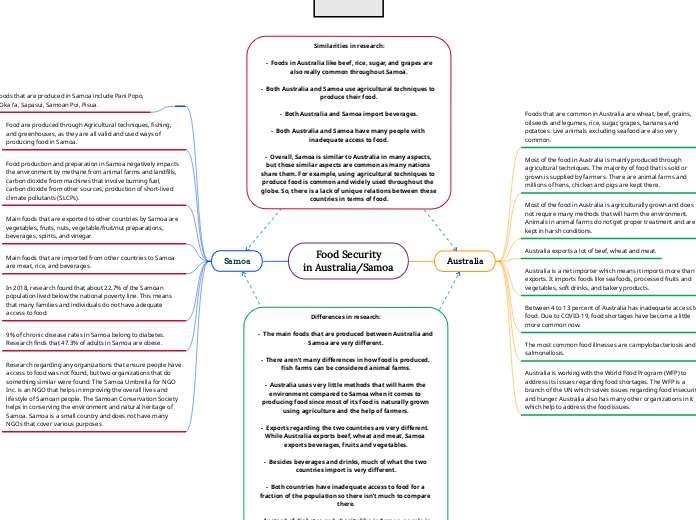Food Security
in Australia/Samoa
Australia
Foods that are common in Australia are wheat, beef, grains, oilseeds and legumes, rice, sugar, grapes, bananas and potatoes. Live animals excluding seafood are also very common.
Most of the food in Australia is mainly produced through agricultural techniques. The majority of food that is sold or grown is supplied by farmers. There are animal farms and millions of hens, chicken and pigs are kept there.
Most of the food in Australia is agriculturally grown and does not require many methods that will harm the environment. Animals in animal farms do not get proper treatment and are kept in harsh conditions.
Australia exports a lot of beef, wheat and meat.
Australia is a net importer which means it imports more than it exports. It imports foods like seafoods, processed fruits and vegetables, soft drinks, and bakery products.
Between 4 to 13 percent of Australia has inadequate access to food. Due to COVID-19, food shortages have become a little more common now.
The most common food illnesses are campylobacteriosis and salmonellosis.
Australia is working with the World Food Program (WFP) to address its issues regarding food shortages. The WFP is a branch of the UN which solves issues regarding food insecurity and hunger. Australia also has many other organizations in it which help to address the food issues.
Samoa
Different foods that are produced in Samoa include Pani Popo, Palusami, Oka i’a, Sapasui, Samoan Poi, Pisua.
Food are produced through Agricultural techniques, fishing, and greenhouses, as they are all valid and used ways of producing food in Samoa.
Food production and preparation in Samoa negatively impacts the environment by methane from animal farms and landfills, carbon dioxide from machines that involve burning fuel, carbon dioxide from other sources, production of short-lived climate pollutants (SLCPs).
Main foods that are exported to other countries by Samoa are
vegetables, fruits, nuts, vegetable/fruit/nut preparations, beverages, spirits, and vinegar.
Main foods that are imported from other countries to Samoa are meat, rice, and beverages.
In 2018, research found that about 22.7% of the Samoan population lived below the national poverty line. This means that many families and individuals do not have adequate access to food.
9% of chronic disease rates in Samoa belong to diabetes. Research finds that 47.3% of adults in Samoa are obese.
Research regarding any organizations that ensure people have access to food was not found, but two organizations that do something similar were found. The Samoa Umbrella for NGO Inc. is an NGO that helps in improving the overall lives and lifestyle of Samoan people. The Samoan Conservation Society helps in conserving the environment and natural heritage of Samoa. Samoa is a small country and does not have many NGOs that cover various purposes.
